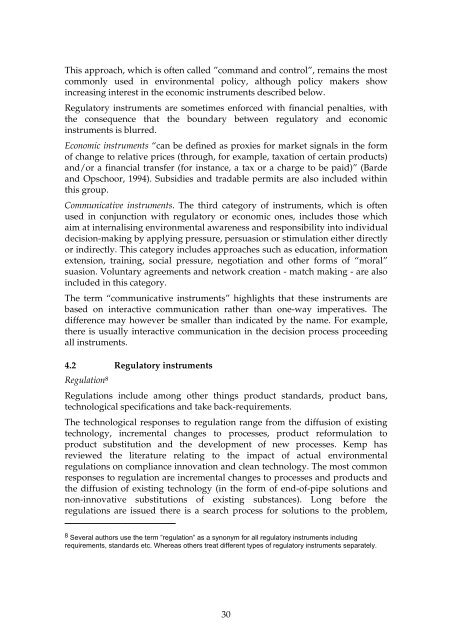Drivers of environmental innovation - Vinnova
Drivers of environmental innovation - Vinnova
Drivers of environmental innovation - Vinnova
Create successful ePaper yourself
Turn your PDF publications into a flip-book with our unique Google optimized e-Paper software.
This approach, which is <strong>of</strong>ten called ”command and control”, remains the most<br />
commonly used in <strong>environmental</strong> policy, although policy makers show<br />
increasing interest in the economic instruments described below.<br />
Regulatory instruments are sometimes enforced with financial penalties, with<br />
the consequence that the boundary between regulatory and economic<br />
instruments is blurred.<br />
Economic instruments “can be defined as proxies for market signals in the form<br />
<strong>of</strong> change to relative prices (through, for example, taxation <strong>of</strong> certain products)<br />
and/or a financial transfer (for instance, a tax or a charge to be paid)” (Barde<br />
and Opschoor, 1994). Subsidies and tradable permits are also included within<br />
this group.<br />
Communicative instruments. The third category <strong>of</strong> instruments, which is <strong>of</strong>ten<br />
used in conjunction with regulatory or economic ones, includes those which<br />
aim at internalising <strong>environmental</strong> awareness and responsibility into individual<br />
decision-making by applying pressure, persuasion or stimulation either directly<br />
or indirectly. This category includes approaches such as education, information<br />
extension, training, social pressure, negotiation and other forms <strong>of</strong> “moral”<br />
suasion. Voluntary agreements and network creation - match making - are also<br />
included in this category.<br />
The term “communicative instruments” highlights that these instruments are<br />
based on interactive communication rather than one-way imperatives. The<br />
difference may however be smaller than indicated by the name. For example,<br />
there is usually interactive communication in the decision process proceeding<br />
all instruments.<br />
4.2 Regulatory instruments<br />
Regulation 8<br />
Regulations include among other things product standards, product bans,<br />
technological specifications and take back-requirements.<br />
The technological responses to regulation range from the diffusion <strong>of</strong> existing<br />
technology, incremental changes to processes, product reformulation to<br />
product substitution and the development <strong>of</strong> new processes. Kemp has<br />
reviewed the literature relating to the impact <strong>of</strong> actual <strong>environmental</strong><br />
regulations on compliance <strong>innovation</strong> and clean technology. The most common<br />
responses to regulation are incremental changes to processes and products and<br />
the diffusion <strong>of</strong> existing technology (in the form <strong>of</strong> end-<strong>of</strong>-pipe solutions and<br />
non-innovative substitutions <strong>of</strong> existing substances). Long before the<br />
regulations are issued there is a search process for solutions to the problem,<br />
8 Several authors use the term ”regulation” as a synonym for all regulatory instruments including<br />
requirements, standards etc. Whereas others treat different types <strong>of</strong> regulatory instruments separately.<br />
30

















